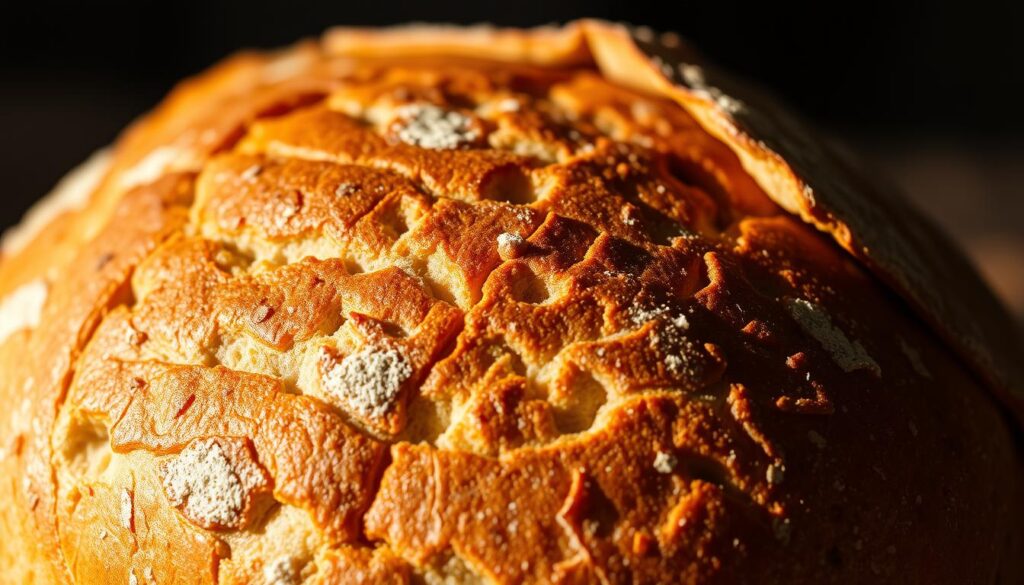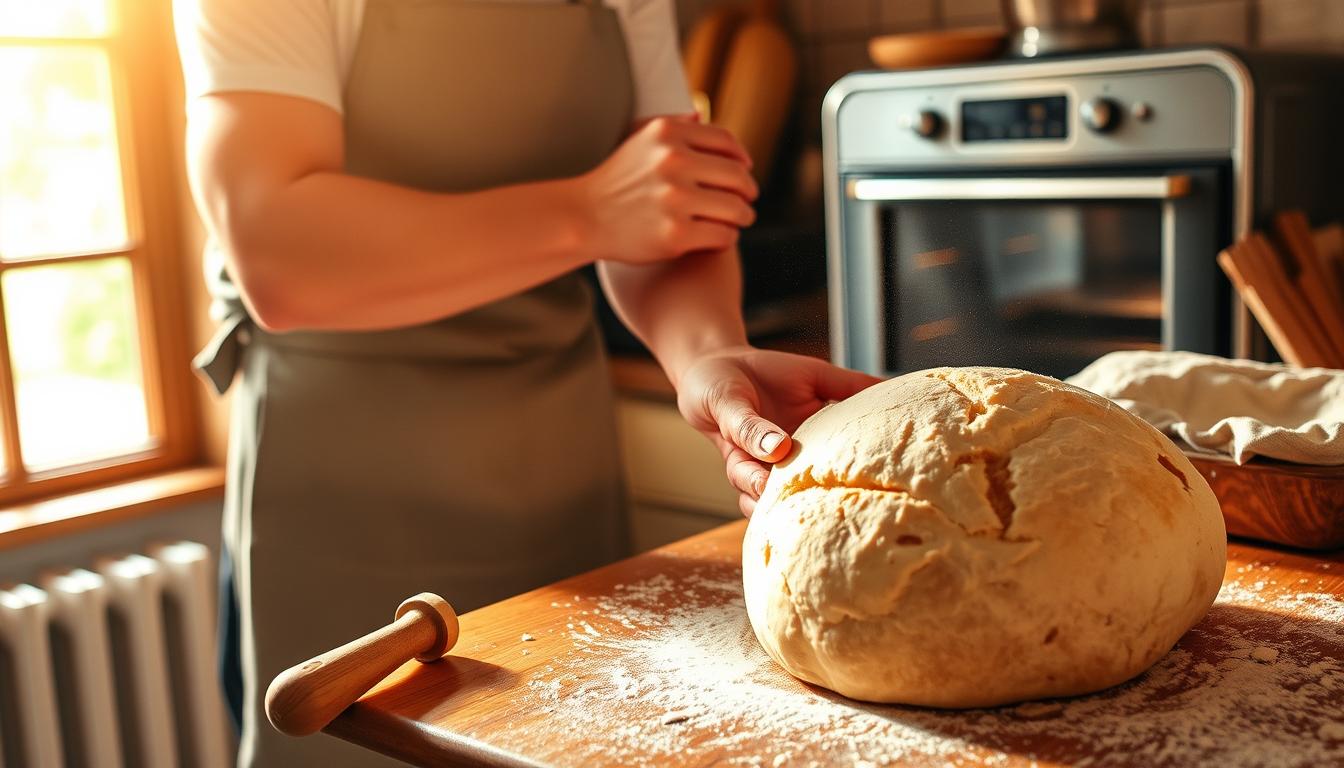Discover the art of making quick German bread. It turns your kitchen into a real bakery. German bread making is more than a skill—it’s a tradition that fills your home with rich flavors and aromas.
Germany has over 1,000 bread varieties. This means you can find easy homemade bread options that are quick to make.
Fast bread baking doesn’t mean you have to give up quality. Whether you’re new to baking or have lots of experience, these tips will help you make delicious German bread. You’ll learn how to make bread quickly without losing its taste or texture.
If you’re looking for another homemade bread recipe, try this Easy Homemade Sandwich Bread Recipe to create a classic white loaf that pairs perfectly with butter or jam.
Key Takeaways
- Learn to make authentic German bread quickly and easily
- Understand the diversity of German bread types
- Master time-saving baking techniques
- Create artisan-quality bread at home
- Explore traditional and modern bread-making methods
Understanding Traditional German Bread Making
German bread making has a long history, with over 300 types of bread. Germany is a paradise for those who love bread and artisan bread.
German bread shows the country’s rich culture and diversity. Each bread has its own story, made with care and local ingredients.
Exploring Bread Varieties
German bread has many types, each with its own special features:
- Vollkornbrot: A hearty whole grain bread packed with nutrition
- Brötchen: Crispy rolls perfect for breakfast
- Pumpernickel: Dark, dense rye bread with unique texture
- Weizenmischbrot: A delightful wheat and rye flour blend
Essential Ingredients for Authentic Flavor
To make authentic German bread, you need certain ingredients:
| Ingredient | Purpose |
|---|---|
| Rye Flour | Provides dense texture and robust flavor |
| Wheat Flour | Adds lightness and structure |
| Sourdough Starter | Enhances complexity and preservation |
Sourdough: The Heart of German Baking
Sourdough is key in German bread making. It adds deep flavors and helps bread last longer. Bakers often use sourdough starters passed down through generations.
“In Germany, bread is not just food; it’s a cultural expression.” – German Baking Tradition
Learning these traditional methods helps you make authentic German bread. It’s a treat for your body and soul.
Quick German Bread: Essential Equipment and Ingredients
Starting your homemade bread journey needs the right tools and ingredients. Easy baking begins with knowing the basics of making rustic bread. You’ll need quality ingredients and the right equipment for your German bread adventure.
Must-Have Baking Equipment
- Large mixing bowl
- Kitchen scale
- Bread knife
- Baking stone or Dutch oven
- Proofing basket
- Instant-read thermometer
Core Ingredients for Authentic German Bread
| Ingredient | Purpose | Recommended Type |
|---|---|---|
| Flour | Base of bread structure | High-protein bread flour |
| Yeast | Fermentation agent | Active dry or instant yeast |
| Salt | Flavor enhancement | Kosher or sea salt |
| Water | Hydration | Filtered room temperature water |
Pro tip: For authentic rustic bread, use organic ingredients whenever possible. The quality of your ingredients directly impacts the final taste and texture of your homemade bread.
“Bread is the king of the table and all else is merely the court that surrounds the king.” – Louis Bromfield
Your baking success depends on precise measurements and quality ingredients. A kitchen scale is key for accurate portioning, ensuring consistent results every time you bake.
Optional Flavor Enhancers
- Sunflower seeds
- Caraway seeds
- Pumpkin seeds
- Dried herbs
By mastering these essential equipment and ingredients, you’ll be ready to make delicious German bread. Your easy baking journey starts here!
The Perfect Sourdough Starter for German Bread
Exploring german baking starts with sourdough mastery. Your journey to homemade artisan bread begins with a lively sourdough starter. This starter captures the heart of German bread-making.
Sourdough starters are key in authentic Quick Germ</strong>an Bread. They turn simple bread making into a magical experience. Knowing how to create and care for your starter is essential for a perfect loaf.
Creating Your Starter from Scratch
Begin your sourdough journey with flour and water. Here’s a simple way to start your starter:
- Use unbleached whole wheat or rye flour for best results
- Mix equal parts flour and water (by weight)
- Let the mixture sit at room temperature (70-75°F)
- Feed your starter daily with fresh flour and water
Maintaining Your Sourdough Culture
Regular care is key for a thriving starter. Follow these tips for easy bread making:
| Maintenance Aspect | Recommendation |
|---|---|
| Feeding Frequency | Daily at room temperature, weekly if refrigerated |
| Feeding Ratio | 1 cup flour, 1/2 cup water per 1 cup starter |
| Storage Container | Non-reactive (stainless steel preferred) |
Troubleshooting Common Starter Issues
Look for these signs of a healthy starter:
- Smell: Tangy to sweet aroma
- Bubbles: Active fermentation indicators
- Consistency: Smooth and slightly elastic
“A good sourdough starter is like a living friend in your kitchen – treat it with care, and it will reward you with delicious bread.” – German Baking Tradition
Embrace german baking by caring for your sourdough starter. With patience and practice, you’ll make artisan bread as good as Germany’s best bakeries.
Time-Saving Techniques for Fast German Bread Making
Baking traditional German bread doesn’t have to take all day. Modern methods like no-knead Quick German Bread can make it quicker. You’ll save time and keep the authentic taste.

The 5-minute bread recipe has changed home baking. You can make tasty bread without hours of kitchen time. Here are some key techniques for quick bread making.
- Use a bread machine to cut preparation time by 50%
- Leverage no-knead techniques for minimal hands-on work
- Utilize cold fermentation for deeper flavor development
- Prepare dough in advance and refrigerate overnight
“The secret to great bread is not time, but technique.” – German Baking Proverb
Knowing about rising times can make bread making faster. Traditional methods take 1-2 hours. But, with smart strategies, you can cut this time down a lot.
| Technique | Time Saved | Flavor Impact |
|---|---|---|
| No-Knead Method | 50-70% reduction | Rich, complex taste |
| Cold Fermentation | Minimal active time | Enhanced depth of flavor |
| Bread Machine | Up to 60% time reduction | Consistent results |
Pro tip: Choose quality ingredients and use shortcuts. Efficiency doesn’t mean compromising on taste. With these tips, you can make delicious German bread even when you’re busy.
No-Knead German Bread Recipe
Discover the simplest way to create an easy German bread that brings authentic flavor to your kitchen. This Quick German Bread will transform your home baking with minimal effort and maximum taste.
Creating a delicious no-knead German bread doesn’t require professional baking skills. With our fast bread baking technique, you’ll craft a stunning loaf that rivals traditional bakery offerings.
Ingredients for Success
- 2 tablespoons instant yeast
- 1 cup lukewarm potato water
- 4-5 cups whole wheat flour
- 2-3 cups lukewarm water
- 1½ teaspoons salt
- ¼ cup molasses
Step-by-Step Mixing Process
Start by mixing yeast with lukewarm potato water. Wait 10 minutes for it to get foamy. Then, mix in flour until you get a soft, sticky dough. Tip: Don’t worry about kneading – this no-knead method embraces simplicity!
Rising and Proofing Techniques
| Stage | Time | Temperature |
|---|---|---|
| Initial Rise | 1-1½ hours | Warm, draft-free area |
| Final Proofing | 30-45 minutes | Room temperature |
Baking to Perfection
Preheat your oven to 375°F. Bake your bread for about 60 minutes. It’s done when tapping the bottom sounds hollow – a classic German bread baker’s trick!
“Baking bread is an art that connects us to generations of tradition.” – Traditional German Baker’s Saying
Your no-knead German bread is now ready to enjoy – crispy crust, soft interior, and packed with authentic flavor. Happy baking!
Mastering the Perfect German Bread Crust

Creating the perfect crust is an art form in German artisan bread making. Your journey starts with understanding the key elements. These elements turn an ordinary loaf into an extraordinary culinary experience.
The secret to an exceptional Quick Germ</strong>an Bread crust lies in several key techniques:
- High-temperature baking
- Steam generation in the oven
- Proper scoring techniques
- Precise ingredient ratios
“A great crust tells the story of the bread before you even take a bite.” – German Baking Tradition
Steam is key in developing that signature crispy exterior. When you add moisture at the start, it creates a special environment. This environment lets the bread expand and develop a golden, crackling crust.
| Technique | Impact on Crust | Recommended Method |
|---|---|---|
| Steam Injection | Crisp Exterior | 1 cup boiling water in cast iron pan |
| Baking Temperature | Color and Texture | 425°F (218°C) |
| Scoring | Bread Expansion | Sharp diagonal cuts |
The Bauernbrot technique involves careful scoring to control bread expansion. Make diagonal cuts about 1/4 inch deep just before baking. This allows beautiful crust formation and even rising.
Your home-baked German bread can rival professional bakery results with these simple yet powerful techniques. Practice and patience will help you develop the perfect artisan bread crust every time.
Storage and Freezing Methods for Homemade German Bread
Keeping your homemade bread fresh is key. Whether it’s a traditional German bread or a quick one, the right storage keeps it tasting great.
Best Practices for Fresh Storage
Your freshly baked German bread needs care to stay fresh. For short-term, room temperature storage is best:
- Wrap bread in a clean cotton cloth or paper bag
- Store at room temperature for 2-3 days
- Keep away from direct sunlight and heat sources
- Avoid plastic bags, which can make the crust soggy
Freezing and Thawing Guidelines
Freezing your bread lets you enjoy it longer. Here’s how to do it right:
| Storage Method | Duration | Recommended Technique |
|---|---|---|
| Freezer Storage | Up to 3 months | Wrap tightly in plastic wrap, then place in freezer-safe bag |
| Thawing Process | 30-45 minutes | Remove from freezer, unwrap, and let sit at room temperature |
| Reheating | 10-15 minutes | Warm in oven at 300°F (150°C) for crisp texture |
“Proper storage is the secret to maintaining the authentic taste of German bread” – German Baking Tradition
Pro tip: Slice your bread before freezing. This makes thawing individual portions easy. It’s perfect for quick bread recipes and keeps your bread fresh.
Common Mistakes to Avoid When Making German Bread
Learning to make homemade artisan bread can be tricky. Even skilled bakers face issues that affect their bread’s quality and texture.
Here are key mistakes to avoid in your bread-making journey:
- Incorrect Water Temperature: Yeast is very sensitive to heat. Water that’s too hot can kill the yeast. Water that’s too cold stops it from working right. The best temperature is between 100-110°F.
- Over-Kneading Dough: Kneading too much makes the dough tough and dense. Use the “window pane test” to check if it’s right. The dough should stretch thin without breaking.
- Inadequate Rising Time: Not giving the dough enough time to rise is a big mistake. Yeast needs time to do its job, usually 1-2 hours in a warm, draft-free spot.
“Patience is the secret ingredient in easy baking” – Professional Baker’s Wisdom
It’s important to watch the dough’s consistency. Good dough feels soft and elastic, bouncing back when you poke it. Using digital scales helps get the right amounts of ingredients.
Don’t worry about mistakes in your German bread-making journey. Each one is a chance to get better and make even tastier homemade bread.
Tips for Adapting German Bread Recipes to Different Climates
Mastering homemade bread means knowing how climate affects german baking. With the right tweaks, your bread can thrive anywhere.
Climate is key in bread making. It changes how dough ferments, rises, and feels in the end.
“The secret to perfect german bread is adapting to your local conditions” – German Baking Masters
Climate Adaptation Strategies
- Watch dough temperature during fermentation
- Change water amounts based on humidity
- Use a controlled proofing area
- Adjust ingredient mix for better results
Temperature Management Techniques
| Climate Type | Recommended Action | Fermentation Adjustment |
|---|---|---|
| Cold/Dry | Use warmer water | Increase proofing time |
| Hot/Humid | Reduce water temperature | Shorten fermentation period |
| Moderate | Maintain 78°F (25°C) | Standard fermentation |
Learning the poke test helps check dough readiness in any climate. Press the dough and see how fast it bounces back to know if it’s ready.
German baking pros stress being flexible. By watching temperature, water, and fermentation, your bread can adapt easily.
Conclusion
Your journey into quick German bread making doesn’t end here. You now know how to make easy homemade bread. This skill connects you to the rich German cuisine.
The methods we’ve explored make baking simple and fun. They fit well into your busy life. Each recipe and technique is more than just food preparation. It’s a cultural exploration.
Whether you’re making traditional sourdough or trying new shortcuts, you’re part of a long tradition. The key is to use both old and new ways to make German bread easy for home bakers.
Remember, practice makes perfect. Your first loaves might not be perfect, but each try gets you closer. Start with simple recipes, know your ingredients, and build your confidence.
The techniques you’ve learned will help you make delicious, aromatic breads. These breads will take you straight to a German kitchen, all from your home.
As you keep baking, don’t be afraid to try new things. German bread making is about tradition, creativity, and enjoying the process. It’s about making something delicious from scratch.
German bread is not only great on its own but pairs beautifully with rich and flavorful dishes like this Delicious Homemade Chicken Dressing Recipe for a comforting meal.

